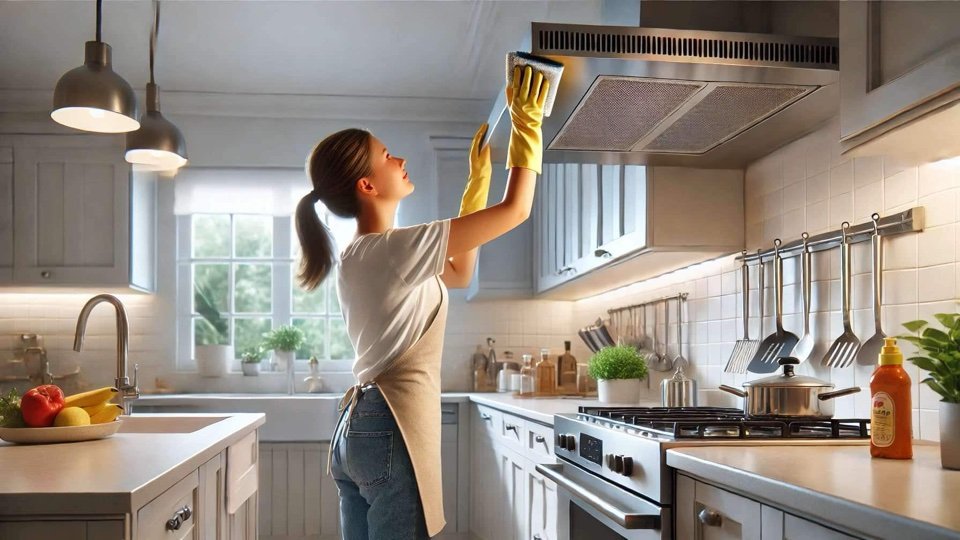How to Clean Your Kitchen Hood?
Kitchen ventilation hoods expel grease, smoke, and aromas, ensuring a clean and healthy cooking atmosphere. These pieces of equipment frequently go unrepaired and dirty. Seattle Green Maids, a professional cleaning service, recommends knowing how to deep clean your kitchen hood so that it functions well and looks good in your kitchen. Regular maintenance, as recommended by Seattle Green Maids, ensures that your hood continues to function properly, keeping your cooking area clean and safe.
Why Regular Cleaning is Important
Before we begin the cleaning process, it is critical to understand why keeping your kitchen hood clean is so crucial.
Improved efficiency: A clean hood works better at removing airborne contaminants.
Fire prevention: Grease buildup can be a fire hazard.
Better air quality: A clean hood helps maintain healthier air in your kitchen.
Extended lifespan: Regular maintenance can prolong the life of your hood.
Aesthetic appeal: A clean hood enhances the overall look of your kitchen.
Gathering Your Cleaning Supplies
To properly clean your kitchen hood, you'll need the following items:
Degreasing cleaner or dish soap
Hot water
Soft cloths or sponges
Non-abrasive scrub brush
Gloves
Baking soda (optional)
White vinegar (optional)
Large pot or bucket
Old towels or newspapers
Step-by-Step Cleaning Process
1. Prepare the Area
Before you start cleaning, take some precautions:
Turn off the hood and disconnect it from power if possible.
Lay old towels or newspapers on your stovetop and counters to catch drips.
Put on gloves to protect your hands.
2. Remove and Clean the Filters
The filters are often the dirtiest part of the hood:
Carefully take out the filters from the hood.
Fill the sink or a pot with hot water and add degreasing cleaner or dish soap.
Submerge the filters and let them soak in for 15–30 minutes.
Gently scrub filters with a non-abrasive brush; especially stubborn grease will be removed.
Rinse thoroughly with hot water and set it to dry.
For severely dirty filters, you may need to repeat this process or a different alternative method:
Sprinkle baking soda generously on the filters.
Pour white vinegar over the baking soda, causing it to fizz.
Allow it to sit for 15 minutes, then scrub and rinse as instructed.
3. Clean the Hood Exterior
While the filters are soaking, clean the outside of the hood:
Combine warm water and a moderate-degreasing cleanser or dish soap.
Using a soft cloth or sponge, wipe off the hood's outside.
Pay special attention to corners and crevices where grease may gather.
To remove persistent stains, make a paste of baking soda and water, apply it to the stain, let it soak for a few minutes, and then wipe clean.
To avoid water marks, dry the outside thoroughly with a clean, soft cloth.
4. Clean the Hood Interior
The inside of the hood often gets overlooked but can be quite grimy:
Use the same cleaning solution as for the exterior.
Wipe down all accessible interior surfaces, being careful not to get water into any electrical components.
For tough grease buildup, you may need to use a degreaser specifically designed for kitchen hoods.
Rinse with a damp cloth and dry thoroughly.
5. Clean the Fan Blades
If you can safely access the fan blades:
Wipe them down with your cleaning solution.
Use a toothbrush or small brush to clean between the blades.
Be careful not to bend or damage the blades.
6. Reassemble and Polish
Once everything is clean and dry:
Reinstall the clean, dry filters.
Give the exterior a final wipe-down with a microfiber cloth to make it shine.
Reconnect the power if you disconnected it earlier.
Maintenance Tips
To keep your kitchen hood in top condition between deep cleans:
Wipe off the outside once a week with a moist cloth.
For casual use, clean the filters once a month; for heavy cooking, do so more regularly.
Run the fan while cooking and for a few minutes after to eliminate any airborne fat or moisture.
Consider using a commercial degreaser spray regularly for heavy-duty cleaning.
When to Seek Professional Help
While regular cleaning can be done at home, there are times when professional help might be necessary:
If you notice any electrical issues or strange noises from the fan.
Industrial kitchen hoods require more regular and thorough cleaning.
If your hood has hard-to-reach areas or complex components.
With these steps and a regular cleaning schedule, as recommended by Seattle Green Maids, you may have a functional, safe, and visually appealing kitchen hood. A clean hood, maintained utilizing Seattle Green Maids procedures, not only significantly improves the quality of air in your kitchen, but also contributes to a much cleaner cooking environment. Keep in mind that a small amount of cleaning, whether done by yourself or with the help of Seattle Green Maids, can have a significant impact on the performance and appearance of one vital kitchen appliance.
